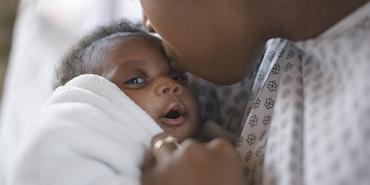The deadly impact of structural racism
In the weeks since the world witnessed the murder of George Floyd by a Minneapolis police officer, thousands of protests across the country and around the globe have amplified the discourse around racism and police brutality. As calls for police reform become louder, there is growing acknowledgment of the need to address structural problems that contribute to persistent disparities in Black communities’ resources. Now, there is evidence that connects the chronic disinvestment in African American communities with police violence against Black people.
Intentional disinvestment in Black communities has created gross inequality and opportunity gaps in education, housing, health and employment. A 2018 paper from researchers at the Boston University School of Public Health suggests that these indicators of structural racism are interconnected with higher rates of police violence.
“Nationally, during the period 2013–2015, Blacks were shot by police at a rate of 3.1 times higher than whites, and unarmed Blacks were shot at a rate of 4.5 times higher,” the report states. In a state-by-state analysis, the study found that “the Black-white disparity between states in the rate of fatal police shootings of unarmed victims are explained by the state’s levels of structural racism.”
Structural racism is defined by the Aspen Institute as, “A system in which public policies, institutional practices, cultural representations, and other norms work in various, often reinforcing ways to perpetuate racial group inequity.” The Urban Institute defines it as, “the historical and contemporary policies, practices, and norms that create and maintain white supremacy.” Structural racism is part of the social, economic and political systems in which we all exist, and it pervades every aspect of our lives. Grantmakers in the Arts, a national association that funds arts and culture, calls structural racism, “the silent opportunity killer.”
“As an African American who has worked in law enforcement for 27 years, I can tell you that systemic and structural racism has always been there,” says Wayne Spence, president of the New York State Public Employees Federation, a parole officer and AFT vice president. “It’s so systemic that there are Black officers who perpetuate the system themselves.”
Spence’s decision to become a law enforcement officer was influenced by his own frequent encounters with the police during his years as a college student in Florida. “It felt like I was getting pulled over all the time by the cops because of racial profiling,” Spence says. “I went into the system to try to change the system. It hasn’t worked.” He says he can attest to the disparities in the policing of Black people and under-resourced communities compared with white people in more affluent communities.
“As an officer, I recall conducting door knocks at 4 a.m., in a Black community, and knocking loudly without consideration for people trying to sleep,” says Spence. “We didn’t do that sort of thing in say, a Jewish or Italian neighborhood with whites, because we knew those folks would report that kind of activity.”
Black law enforcement officials are, themselves, sometimes targeted by fellow police, he says. “I remember working with some officers to plan a raid on a suspected drug house,” Spence recalls. “During the operation, one of the uniformed officers grabbed me—I was in plainclothes—and put a gun to my head, because he assumed I was a Black man on the scene with a gun, so I must be a suspect. How does that even happen? It’s because they didn’t really see me. They just saw a Black face.”
The reality of structural racism in law enforcement is why Spence joined an organization called 100 Blacks in Law Enforcement Who Care, a New York City–based advocacy group that speaks out against police brutality, racial profiling and police misconduct.
“I’m Black, and I’m in law enforcement, but when the Black Lives Matter movement first became visible, I had conflicting emotions,” Spence admits. “But watching the video footage of Walter Scott getting shot in the back while fleeing on foot from police, that incident went against everything I was taught in training as a law enforcement officer.”
Officers are trained to use only the amount of force necessary to mitigate an incident, make an arrest or protect themselves and others from harm, Spence explains. “If a guy hits me with his hand, I do not shoot him.”
“I’ve seen reports where a white suspect has tasered a cop, but the cop manages to arrest the person without violence or incident,” he says. “Why is it when they interact with Black folks, they engage in excessive force? It’s because some of them see us as animals, not as humans. That’s why we have to say that Black Lives Matter.”
The intersection of structural racism and the determinants of health (like exposure to environmental toxins and access to fresh foods) is the likely cause of “pronounced, persistent and pervasive” health inequities among Blacks and other people of color, according to an article, “Structural Racism and Health Inequities: Old Issues, New Directions,” published by the National Institute of Health.
More than a century ago, W. E. B. Du Bois—civil rights activist, sociologist and a founding member of the NAACP—noted the connection between societal inequities and health outcomes. Du Bois challenged the common late 19th and early 20th century belief that the differences in Black and white mortality and morbidity were due to racial inferiority. Instead, Du Bois maintained, there is empirical evidence linking the legacy of slavery and racism to the poor health of Blacks.
Today, the health of African Americans is worse than most other groups. Black people face higher risks for chronic illness, infection and injury compared with whites, and the average lifespan for Blacks is six years fewer than whites. The current health pandemic has uncovered and deepened long-standing inequities in healthcare and in factors that impact health (like living wages), evidenced by the disproportionate infection and death rates among African Americans. To date, some 136,000 people in the United States have died from the coronavirus and more than 3 million have been infected, but the death rate for Black people is more than two times higher than for whites.
In May, AFT’s Healthcare division released a position paper, “COVID-19 and Racial Equity,” that outlines the ways in which structural racism has affected heath and healthcare, leading to more dire outcomes from the coronavirus pandemic among Black people and most communities of color. It also offers four policy recommendations around addressing the immediate need for better healthcare access, economic relief, safe public housing and long-term healthcare reforms.
“Implicit bias in hospitals and healthcare, in terms of how patients receive care, is evidenced in disparities in how Blacks and whites are treated and diagnosed,” says Nate Gilliam, lead organizer for the Wisconsin Federation of Nurses and Health Professionals, and a member of AFT’s Task Force on Health Equity.
The task force was created by a resolution passed by delegates to AFT’s 2018 biennial convention. The resolution calls on our union to recommend actions at the state and local levels to help create a healthcare workforce that reflects the community being served and ensure “a care and delivery system that eliminates rather than perpetuates racial disparities.”
The Task Force on Health Equity has worked to address the issue of Black maternal health. Black women in the United States have shockingly poor maternal health outcomes, including disproportionately high rates of death related to pregnancy or childbirth.
New Jersey has the highest maternal mortality rate in the nation for Black women, at 102.3 deaths per 100,000 live births. Black women are almost five times more likely than white women to die during childbirth, accounting for 47 percent of maternal deaths in New Jersey for a group that represents only 13 percent of the state’s population.
“One of the challenges related to healthcare equity is that Blacks tend to be treated differently, so healthcare outcomes are different,” says Alexis Rean-Walker, secretary-treasurer of Health Professionals and Allied Employees in New Jersey and a member of AFT’s Healthcare Inequities Task Force. “All too often, African Americans are not valued or heard.”
Rean-Walker pointed to the high-profile examples of professional tennis player Serena Williams and singer Beyoncé Knowles Carter. Williams has said she nearly died after giving birth to her daughter in 2017. She has reported in interviews that, the day after she gave birth, her initial complaints of pain signaling complications were ignored. Carter, who gave birth to twins in 2017, has said she also had a potential fatal complication during her pregnancy.
“We need to address the structural issues so that everyone is treated fairly, and we need to invest in efforts to improve access to quality healthcare by expanding it to all,” Rean-Walker continues. “It’s time to make sure that all patients have their voices heard and that all lives are valued.”
[Angela Callahan]
Note: This is the first of a three-part series.


